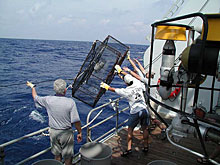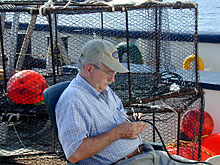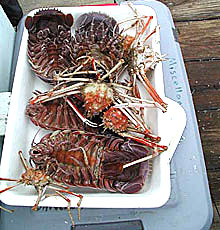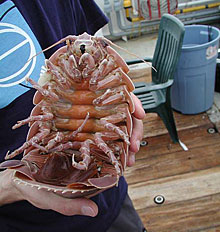
The ship crew lifts a trap on board while the scientists stand by in eager anticipation. Click image for a larger view.
Trapping for Predators, Diving for Prey
October 13, 2002
Bob Carney
Louisiana State University
One of the scientific objectives of the expedition is to determine how the lush chemosynthetic communities might interact with the normal deep-sea fauna of the vast muddy plains and hills that comprise most of the ocean bottom. Are the seep communities self-contained or do they provide food to the adjacent environment? To answer this question we use two primary methods: the ancient skill of trapping and the very modern technology of stable isotope analysis.
It has been determined from previous deep-sea exploration that a few large predators and scavengers inhabit the sea floor between 200 and 1000 meters. Such animals probably eat seep mussels, tubeworms and associated fauna. These animals are targets of our research and we catch them from the submersible or catch them in traps. Trapping in 500 meters of water is not much different than trapping in one meter; you just need a lot more rope to reach the bottom. Last week, we attached a large z-shaped trap to 1000 meters of rope, baited it with fish, tied the end of the rope to a bright orange surface buoy and threw it into the ocean. We recorded the position of the buoy with the ship’s global positioning system, which uses satellites to pinpoint exact positions on the earth. Yesterday, after the trap had been on the bottom for several days, we hauled it back on board. The catch was scientifically very rewarding. From dive observations we know that large crabs (Rochina), fish called hake and giant isopods (Bathynomus) are the most common large predators and scavengers in this area. Most of these big animals are too fast for the submersible to catch, but the trap caught many specimens of each. Tissues from each specimen will be analyzed for carbon, nitrogen and sulfur isotopes in the lab of Dr. Steve Macko at the University of Virginia. These tests will reveal whether any seep animals are included in the diets of predators or scavengers.
Rochina crabs look a lot like the Alaskan crabs you buy in the market, and hake is a close relative of cod fish of fish-and-chips fame. However Bathynomus giganteus, the giant isopod, is unlike anything most people have ever imagined. It is a close relative of the pill bugs, rolly pollies and sowbugs found in houses and gardens. This particular species is by far

Dr. Bob Carney sits near his traps, while splicing together the long trap lines. Click image for a larger view.
Sign up for the Ocean Explorer E-mail Update List.

























